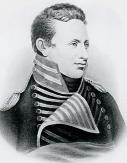Zebulon Pike
|
|
Zebulon Montgomery Pike (January 5, 1779–April 27, 1813) was an American soldier and explorer for whom Pikes Peak in Colorado is named. His Pike expedition, often compared to the Lewis and Clark expedition, mapped much of the southern portion of the Louisiana Purchase.
Pike was born in Lamberton, New Jersey. His father, also Zebulon Pike, was an officer in the United States Army under General George Washington and remained in service after the end of the Revolutionary War. Pike grew to adulthood in a series of Midwestern outposts—then the frontier of the United States—in Ohio and Illinois. He joined his father's regiment as a cadet in 1794, earned a commission as ensign in 1799 and a first lieutenancy later that year.
Pike married in 1801 and continued an unremarkable military career in logistics and payroll at a series of frontier posts. His career was taken up by General James Wilkinson, a political ally of Aaron Burr of mixed allegiance who had been appointed Governor of the Upper Louisiana Territory. In 1805 Wilkinson ordered Pike to explore the headwaters of the Mississippi River. The Lewis and Clark expedition had followed the Missouri River northwest from St. Louis, and American claims on the most northern part of the Louisiana Territory remained unasserted.
Pike left St. Louis by keelboat on August 9 with a force of 20 soldiers. At Prairie du Chien, Wisconsin, he negotiated a settlement between the Chippewa and the Sioux. On September 23 at the juncture of the Mississippi and the Minnesota River he purchased land near the Saint Anthony Falls from the Sioux for what would become Fort Snelling. He also built a stockade near Little Falls, Minnesota in October, and left a company of men there.
Continuing through worsening weather, Pike reached Leech Lake, which he misidentified as the source of the Mississippi, and Cass Lake. His efforts to close British forts at the lakes, though vigorous, were unsuccessful. Pike returned with his men to St. Louis on April 30, 1806 with little to show for their efforts.
Nearly immediately upon his return, Pike was ordered out once again to lead an exploratory expedition west. Near St. Louis, Missouri on July 15, 1806, Pike led the Pike expedition from Fort Bellefontaine to explore the west. This journey, which became his life's achievement, ended with his imprisonment in New Mexico by Spanish authorities. See Pike expedition for full article.
On his return to freedom, Pike was promoted to captain and thence up the ranks to colonel in 1812. His account of his expedition was published in 1810 and later published in French and Dutch. He continued his role as a military functionary, serving as deputy quartermaster-general in New Orleans and inspector-general in the War of 1812.
Pike, along with General Jacob Brown, departed from a rural military outpost, Sackets Harbor, on the New York shore of Lake Ontario, for his last military campaign. On this expedition, Pike commanded combat troops in the successful attack on York, Ontario (now Toronto) on April 27, 1813. Upon completion of this mission, Pike was killed by a chunk of flying rock when a retreating British garrison exploded its ammunition store. His body was carried by ship back to Sackets Harbor, where his remains lay buried today.
Pike County, Ohio, Pike County, Alabama and USS General Pike are named in his honor.
External link
- Park Service biography (http://www.nps.gov/jeff/LewisClark2/Circa1804/WestwardExpansion/EarlyExplorers/ZebulonPike.htm)de:Zebulon Pike

